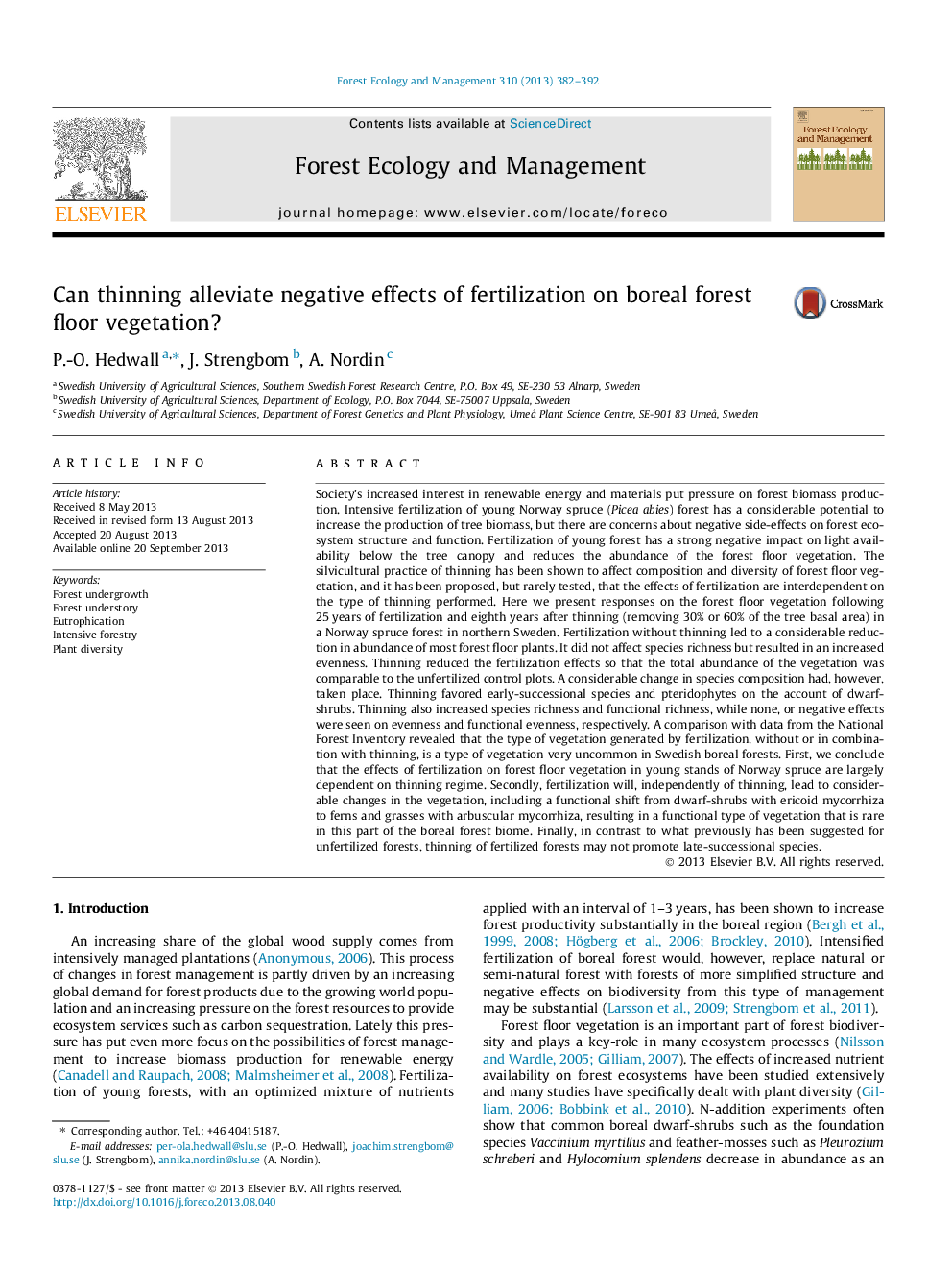| کد مقاله | کد نشریه | سال انتشار | مقاله انگلیسی | نسخه تمام متن |
|---|---|---|---|---|
| 6543725 | 159212 | 2013 | 11 صفحه PDF | دانلود رایگان |
عنوان انگلیسی مقاله ISI
Can thinning alleviate negative effects of fertilization on boreal forest floor vegetation?
ترجمه فارسی عنوان
آیا می توان نازک شدن اثرات منفی لقاح را در پوشش گیاهان جنگلی بئرال کاهش داد؟
دانلود مقاله + سفارش ترجمه
دانلود مقاله ISI انگلیسی
رایگان برای ایرانیان
کلمات کلیدی
جنگل زیرزمینی، درخت جنگل، یوتروفیزیک، جنگل انبوه، تنوع گیاهی،
موضوعات مرتبط
علوم زیستی و بیوفناوری
علوم کشاورزی و بیولوژیک
بوم شناسی، تکامل، رفتار و سامانه شناسی
چکیده انگلیسی
Society's increased interest in renewable energy and materials put pressure on forest biomass production. Intensive fertilization of young Norway spruce (Picea abies) forest has a considerable potential to increase the production of tree biomass, but there are concerns about negative side-effects on forest ecosystem structure and function. Fertilization of young forest has a strong negative impact on light availability below the tree canopy and reduces the abundance of the forest floor vegetation. The silvicultural practice of thinning has been shown to affect composition and diversity of forest floor vegetation, and it has been proposed, but rarely tested, that the effects of fertilization are interdependent on the type of thinning performed. Here we present responses on the forest floor vegetation following 25Â years of fertilization and eighth years after thinning (removing 30% or 60% of the tree basal area) in a Norway spruce forest in northern Sweden. Fertilization without thinning led to a considerable reduction in abundance of most forest floor plants. It did not affect species richness but resulted in an increased evenness. Thinning reduced the fertilization effects so that the total abundance of the vegetation was comparable to the unfertilized control plots. A considerable change in species composition had, however, taken place. Thinning favored early-successional species and pteridophytes on the account of dwarf-shrubs. Thinning also increased species richness and functional richness, while none, or negative effects were seen on evenness and functional evenness, respectively. A comparison with data from the National Forest Inventory revealed that the type of vegetation generated by fertilization, without or in combination with thinning, is a type of vegetation very uncommon in Swedish boreal forests. First, we conclude that the effects of fertilization on forest floor vegetation in young stands of Norway spruce are largely dependent on thinning regime. Secondly, fertilization will, independently of thinning, lead to considerable changes in the vegetation, including a functional shift from dwarf-shrubs with ericoid mycorrhiza to ferns and grasses with arbuscular mycorrhiza, resulting in a functional type of vegetation that is rare in this part of the boreal forest biome. Finally, in contrast to what previously has been suggested for unfertilized forests, thinning of fertilized forests may not promote late-successional species.
ناشر
Database: Elsevier - ScienceDirect (ساینس دایرکت)
Journal: Forest Ecology and Management - Volume 310, 15 December 2013, Pages 382-392
Journal: Forest Ecology and Management - Volume 310, 15 December 2013, Pages 382-392
نویسندگان
P.-O. Hedwall, J. Strengbom, A. Nordin,
